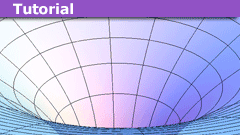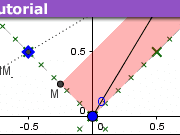Learn Orbital Precession in the Schwarzschild and Kerr Metrics
Table of Contents
The Schwarzschild Metric
A Lagrangian that can be used to describe geodesics is [itex]F = g_{\mu\nu}v^\mu v^\mu[/itex], where [itex]v^\mu = dx^\mu/ds[/itex] is the four-velocity. In the equatorial plane of the Schwarzschild metric this is
$$F = (1 – 2m/r)^{-1} (dr/ds)^2 + r^2(d\phi/ds)^2 – (1 – 2m/r)(dt/ds)^2$$
The canonical momenta are [itex]p_\mu = \partial F/\partial v^\nu = g_{\mu\nu}v^\nu[/itex]. Since the Lagrangian is independent of [itex]t[/itex] and [itex]\phi[/itex], we have two immediate first integrals
[tex]\begin{eqnarray*}L & = & g_{\phi \nu}u^\nu = r^2(d\phi/ds)\\
\Gamma & = & g_{t \nu} u^\nu = (1 – 2m/r)(dt/ds)\end{eqnarray*}[/tex]
along with the constraint [itex]F = -1[/itex].
Physically, [itex]L[/itex] represents the angular momentum per unit mass and has dimensions of distance. [itex]\Gamma[/itex]
represents the energy per unit mass and is dimensionless. In other words, [itex]\Gamma[/itex] is just the usual relativistic gamma factor. [itex]F[/itex] is the norm of the four-velocity.
Combining all three, we obtain the radial equation of motion:
$$(dr/ds)^2 = \Gamma^2 – (1 – 2m/r) – (1 – 2m/r)(L^2/r^2) \equiv V(r)$$
Circular Orbits
For a circular orbit, [itex]V(r) = V'(r) = 0[/itex]. These condiitions can be used to determine the constants of the motion [itex]L^2[/itex] and [itex]\Gamma^2[/itex] in terms of the orbital radius:
[tex]\begin{eqnarray*}V(r) & = & 0 \Rightarrow \Gamma^2 = 1 – 2m/r + L^2/r^2 – 2mL^2/r^3\\
V'(r) & = & 0 \Rightarrow 0 = -2m/r^2 + 2L^2/r^3 – 6mL^2/r^4\end{eqnarray*}[/tex]
from which we find
\begin{eqnarray*}L^2 & = & \frac{mr}{1 – 3m/r}\\
\Gamma^2 & = & \frac{(1 – 2m/r)^2}{1 – 3m/r}\end{eqnarray*}
Note that both [itex]L^2[/itex] and [itex]\Gamma^2[/itex] go to infinity at [itex]r = 3m[/itex], which is the radius at which a photon can undergo a circular orbit. Inside [itex]r = 3m[/itex] they both become negative, and circular orbits of any kind are not possible.
Radial Oscillations
Small radial oscillations are governed by the second derivative [itex]V”(r)[/itex].
For Schwarzschild,
$$V”(r) = 4m/r^3 – 6L^2/r^4 + 24mL^2/r^5 = – \frac{2m}{r^3} \frac{1-6m/r}{1-3m/r}$$
To obtain the equation of the orbit, let $(d\phi/ds)^2 = L^2/r^4 \equiv D(r)$. Then
$$(dr/d\phi)^2 = \frac{(dr/ds)^2}{(d\phi/ds)^2} = \frac{V(r)}{D(r)}$$
Small oscillations about a circular orbit will be governed by:
$$(d\delta r/d\phi)^2 = \frac{(1/2) V”(r)}{D(r)} (\delta r)^2$$
A radial oscillation takes the form [itex]\delta r \sim \sin(\omega \phi)[/itex], so the above implies
$$ \omega ^2 = – \frac{(1/2)V”(r)}{D(r)} = 1 – 6m/r$$
This shows that all circular orbits inside [itex]r = 6m[/itex] are unstable, since [itex]\omega^2 < 0[/itex] there. Outside $r = 6m$,
oscillations are stable. For a complete orbit, in which [itex]\phi[/itex] increases by [itex]2\pi[/itex], the phase of a radial motion will increase by [itex]2\pi \omega[/itex]. The difference between these two quantities represents the advance of the perihelion,
namely [itex]6\pi m/r[/itex] per revolution.
The Kerr Metric
Analysis of the perihelion advance in the case of the Kerr metric is quite similar, although a bit more complicated.
The Kerr metric in Boyer-Lindquist coordinates, restricted to the equatorial plane is:
$$ds^2 = (1 -2m/r) dt^2 – r^2/\Delta dr^2 – (r^2 + a^2 + 2ma^2/r) d\phi^2 + (4ma/r) d\phi dt$$
where
$$\Delta = r^2 – 2mr + a^2$$
The first integrals are:
\begin{eqnarray*}L & = & g_{\phi \mu}v^\mu = (2ma/r) (dt/ds) – (r^2 + a^2 + 2ma^2/r) (d\phi/ds)\\
\Gamma & = & g_{t \mu} v^\mu = (1 – 2m/r) (dt/ds) + (2ma/r) (d\phi/ds)\end{eqnarray*}
or conversely
\begin{eqnarray*}d\phi/ds & = & g^{\phi t} \Gamma + g^{\phi \phi}L = (1/r\Delta)(2ma\Gamma – (r – 2m)L)\\
dt/ds & = & g^{t t}\Gamma + g^{t \phi}L = (1/r\Delta)((r^2 + a^2 + 2ma^2/r)\Gamma + 2ma L)\end{eqnarray*}
The Lagrangian for geodesics:
$$F = g^{\mu\nu}v_\mu v_\nu = g^{tt}\Gamma^2 + 2g^{t \phi} \Gamma L + g^{\phi\phi} L^2 + g_{rr}(dr/ds)^2$$
Combining these:
$$1 = (1/\Delta)(r^2 + a^2 + 2ma^2/r) \Gamma^2 + (4ma/r\Delta) \Gamma L – (1/\Delta)(1 – 2m/r) L^2 – (r^2/\Delta) (dr/ds)^2$$
we get the radial equation of motion:
[tex]\begin{eqnarray*}(dr/ds)^2 & = & – (\Delta/r^2) + (1/r^2)(r^2 + a^2 + 2ma^2/r) \Gamma^2 + (4ma/r^3)\Gamma L – (1 – 2m/r)L^2/r^2\\
& = & – (\Delta/r^2) + \Gamma^2 (r^2 + a^2)/r^2 – L^2/r^2 + (2m/r^3)(a\Gamma + L)^2 \mathbf{\equiv V(r)}\end{eqnarray*}[/tex]
Circular Orbits
For a circular orbit, [itex]V(r) = V'(r) = 0[/itex].
[tex]\begin{eqnarray*}V(r) & = & 0 \Rightarrow 0 = \Gamma^2(1 + a^2/r^2) – (r^2 + L^2)/r^2 – a^2/r^2 + 2m/r + (2m/r^3)(a\Gamma + L)^2\\
V'(r) & = & 0 \Rightarrow 0 = \Gamma^2(-2a^2/r^3) + 2L^2/r^3 + 2a^2/r^3 – 2m/r^2 – (6m/r^4)(a\Gamma + L)^2\end{eqnarray*}[/tex]
These can be simplified by taking linear combinations and multiplying by [itex]r^4[/itex]:
[tex]\begin{eqnarray*}3V(r)r^3 + V'(r)r^4 & = & 0 \Rightarrow L^2 = (\Gamma^2 – 1)(3r^2 + a^2) + 4mr\\
2V(r)r^3 + V'(r)r^4 & = & 0 \Rightarrow m(a\Gamma + L)^2 = r^3(\Gamma^2 – 1) + mr^2\\
& = & ma^2 \Gamma^2 + 2maL \Gamma + m[(\Gamma^2 – 1)(3r^2 + a^2) + 4mr]\\
2maL \Gamma & = & \Gamma^2 (r^3 – 3mr^2 – 2ma^2) + 4mr^2 – r^3 + ma^2 – 4m^2r\end{eqnarray*}[/tex]
By squaring the latter, [itex]L[/itex] can now be eliminated, leading to a quadratic equation for [itex]\Gamma^2[/itex].
The solutions are:
$$\Gamma = \frac{1 – 2m/r – (a/r^2) \sqrt{mr}}{\sqrt{1 – 3m/r – (2a/r^2) \sqrt{mr}}}$$
$$L = \frac{\sqrt{mr} – 2am/r – (a^2/r^2)\sqrt{mr}}{\sqrt{1 – 3m/r – (2a/r^2)\sqrt{mr}}}$$
As before, circular photon orbits exist where the denominators of [itex]L[/itex] and [itex]\Gamma[/itex] vanish.
Radial Oscillations
Once again, the frequency of small radial oscillations is governed by [itex]V”(r)[/itex]:
$$V”(r) = \Gamma^2(6a^2/r^4) – 6L^2/r^4 – 6a^2/r^4 + 4m/r^3 + (24m/r^5)(a\Gamma + L)^2$$
From this point on, we assume that a is small, and keep only terms of first order.
[tex]\begin{eqnarray*}\Gamma^2 & \approx & \frac{(1 – 2m/r)^2}{1 – 3m/r} + \frac{(2am/r^3)\sqrt{mr}(1 – 2m/r)}{(1 – 3m/r)^2}\\
L^2 & \approx & \frac{mr}{1 – 3m/r} + \frac{(6am/r)\sqrt{mr}(1 – 2m/r)}{(1 – 3m/r)^2}\\
(a\Gamma + L)^2 & \approx & \frac{mr}{1 – 3m/r} + \frac{2a\sqrt{mr}(1 – 2m/r)}{(1 – 3m/r)^2}\\
V”(r) & \approx & – \frac{(2m)(1 – 6m/r)}{r^3(1 – 3m/r)} + \frac{12am\sqrt{mr}}{r^5}\frac{1 – 2m/r}{r^5(1 – 3m/r)^2}\\
(d\phi/ds)^2 & = & D(r) = \frac{L^2}{r^4} – \frac{(4ma/r^5)\Gamma L}{1 – 2m/r} \approx \frac{m}{r^3(1 – 3m/r)} + \frac{2am\sqrt{mr}}{r^5(1 – 3m/r)^2}\\
\frac{V”(r)}{D(r)} & \approx & -2 (1 – 6m/r) + \frac{12a\sqrt{mr}}{r^2}\frac{1 – 2m/r}{1 – 3m/r} + \frac{4a\sqrt{mr}}{r^2}\frac{1 – 6m/r}{1 – 3m/r}\\
& = & -2(1 – 6m/r) + \frac{16a\sqrt{mr}}{r^2}\end{eqnarray*}[/tex]
Following the same reasoning as for Schwarzschild, the rate of small radial oscillations in the Kerr metric is therefore
$$\omega^2 = 1 – 6m/r – 8a\sqrt{m/r^3}$$
indicating that the perihelion advance per orbit is
$$6\pi m/r + 8\pi a\sqrt{m/r^3}$$
— This article was originally part of Physics Forums member Bill_K‘s PF blog. He may not respond to comments.
Next up:
William Kinnersley earned his Ph.D. from Caltech in 1968, under the direction of Kip Thorne.








Very nicely, clearly, and succinctly presented – thank you for this :)
The first one is new to me (reading now, thanks), but I have seen the latter, very nice derivations for 2+1D and 3+1D. I wonder why the authors stopped short of providing equations for ##frac {d t} {d tau}## and ##frac {d phi} {d tau}## though.This is an issue ATM because I think I have found a disagreement between Wilkins and Kraniotis et. al. in the ##Theta## potential . . . my eyes say so and so does Maxima.[EDIT] pardon this but I've just showed in Maxima that they are equal after all. Since the Kerr-deSitter ##Theta## potential is simpler, I shall use it for Kerr (##Lambda = 0##) simulations in preference to the form in Wilkins.
Thanks! You may know about this article; it's not about the geodesics just the geometry of the Kerr solution, with a reasonable amount of detail on the 'ring singularity' and the closed timelike curves it gives rise to – those were my main concerns this weekend:
I just noticed this:
You may know all this stuff, but it seems nice.
[QUOTE="john baez, post: 5557997, member: 8778"]What I'd really love to see is a study of orbits in a Kerr metric that describes a 'super-extremal' black hole, one with ##J^2 > M^2##. These could get pretty weird!”Good idea! I went away and commented out the horizon calculations in my own minimal simulator (I started a thread for it but struggling to find it ATM!), and tried a fairly complex bound 3+1D orbit with a = 1.1 and a = 1.5. Both produced "valid" orbits. It seems on the face of it that the equations of motion do not care about the existence of horizons ;)For info, the equations I use are from this paper for the Kerr-deSitter spacetime, and previously the seminal Wilkins paper. Both are full 3+1D solutions based on Hamilton-Jacobi analysis.
Thanks for the Post! Could someone explain where the conclusion about the photon orbits come from, i.e. that they exist for vanishing denominators of ##L## and ##Gamma##?
Nice post! There's a typo:[quote]Outside $r = 6m$, oscillations are stable.[/quote]I guess you need something like two pound signs to do math here, not a dollar sign. Also, there are a number of bad line breaks – WordPress blogs are unforgiving when you hit the carriage return.What I'd really love to see is a study of orbits in a Kerr metric that describes a 'super-extremal' black hole, one with ##J^2 > M^2##. These could get pretty weird!
Thanks for the thread! This is an automated courtesy bump. Sorry you aren't generating responses at the moment. Do you have any further information, come to any new conclusions or is it possible to reword the post? The more details the better.